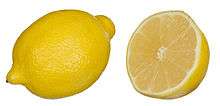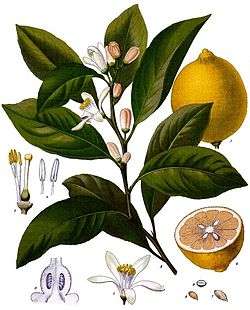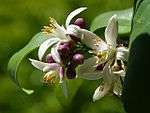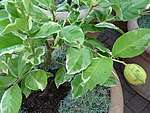Lemon
The lemon, Citrus limon (L.) Osbeck, is a species of small evergreen tree in the flowering plant family Rutaceae, native to South Asia, primarily North eastern India. Its fruits are round in shape.
| Lemon | |
|---|---|
| A fruiting lemon tree. A blossom is also visible. | |
| Scientific classification | |
| Kingdom: | Plantae |
| Clade: | Tracheophytes |
| Clade: | Angiosperms |
| Clade: | Eudicots |
| Clade: | Rosids |
| Order: | Sapindales |
| Family: | Rutaceae |
| Genus: | Citrus |
| Species: | C. limon |
| Binomial name | |
| Citrus limon (L.) Osbeck | |
| Synonyms[1] | |
|
List
| |
The tree's ellipsoidal yellow fruit is used for culinary and non-culinary purposes throughout the world, primarily for its juice, which has both culinary and cleaning uses.[2] The pulp and rind are also used in cooking and baking. The juice of the lemon is about 5% to 6% citric acid, with a pH of around 2.2, giving it a sour taste. The distinctive sour taste of lemon juice makes it a key ingredient in drinks and foods such as lemonade and lemon meringue pie.
History

The origin of the lemon is unknown, though lemons are thought to have first grown in Assam (a region in northeast India), northern Burma or China.[2] A genomic study of the lemon indicated it was a hybrid between bitter orange (sour orange) and citron.[3][4]
Lemons entered Europe near southern Italy no later than the second century AD, during the time of Ancient Rome.[2] However, they were not widely cultivated. They were later introduced to Persia and then to Iraq and Egypt around 700 AD.[2] The lemon was first recorded in literature in a 10th-century Arabic treatise on farming, and was also used as an ornamental plant in early Islamic gardens.[2] It was distributed widely throughout the Arab world and the Mediterranean region between 1000 and 1150.[2]
The first substantial cultivation of lemons in Europe began in Genoa in the middle of the 15th century. The lemon was later introduced to the Americas in 1493 when Christopher Columbus brought lemon seeds to Hispaniola on his voyages. Spanish conquest throughout the New World helped spread lemon seeds. It was mainly used as an ornamental plant and for medicine.[2] In the 19th century, lemons were increasingly planted in Florida and California.[2]
In 1747, James Lind's experiments on seamen suffering from scurvy involved adding lemon juice to their diets, though vitamin C was not yet known as an important dietary ingredient.[2][5]
The origin of the word lemon may be Middle Eastern.[2] The word draws from the Old French limon, then Italian limone, from the Arabic laymūn or līmūn, and from the Persian līmūn, a generic term for citrus fruit, which is a cognate of Sanskrit (nimbū, “lime”).[6]
Varieties

The 'Bonnie Brae' is oblong, smooth, thin-skinned and seedless.[7] These are mostly grown in San Diego County, USA.[8]
The 'Eureka' grows year-round and abundantly. This is the common supermarket lemon,[9] also known as 'Four Seasons' (Quatre Saisons) because of its ability to produce fruit and flowers together throughout the year. This variety is also available as a plant to domestic customers.[10] There is also a pink-fleshed Eureka lemon, with a green and yellow variegated outer skin.[11]
The 'Femminello St. Teresa', or 'Sorrento'[12] is native to Italy. This fruit's zest is high in lemon oils. It is the variety traditionally used in the making of limoncello.
The 'Yen Ben' is an Australasian cultivar.[13]
| Nutritional value per 100 g (3.5 oz) | |
|---|---|
| Energy | 121 kJ (29 kcal) |
9.32 g | |
| Sugars | 2.5 g |
| Dietary fiber | 2.8 g |
0.3 g | |
1.1 g | |
| Vitamins | Quantity %DV† |
| Thiamine (B1) | 3% 0.04 mg |
| Riboflavin (B2) | 2% 0.02 mg |
| Niacin (B3) | 1% 0.1 mg |
| Pantothenic acid (B5) | 4% 0.19 mg |
| Vitamin B6 | 6% 0.08 mg |
| Folate (B9) | 3% 11 μg |
| Choline | 1% 5.1 mg |
| Vitamin C | 64% 53 mg |
| Minerals | Quantity %DV† |
| Calcium | 3% 26 mg |
| Iron | 5% 0.6 mg |
| Magnesium | 2% 8 mg |
| Manganese | 1% 0.03 mg |
| Phosphorus | 2% 16 mg |
| Potassium | 3% 138 mg |
| Zinc | 1% 0.06 mg |
| |
| †Percentages are roughly approximated using US recommendations for adults. Source: USDA Nutrient Database | |
Nutrition and phytochemicals
Lemon is a rich source of vitamin C, providing 64% of the Daily Value in a 100 g reference amount (table). Other essential nutrients are low in content.
Lemons contain numerous phytochemicals, including polyphenols, terpenes, and tannins.[14] Lemon juice contains slightly more citric acid than lime juice (about 47 g/l), nearly twice the citric acid of grapefruit juice, and about five times the amount of citric acid found in orange juice.[15]
Culinary uses
Lemon juice, rind, and peel are used in a wide variety of foods and drinks. The whole lemon is used to make marmalade, lemon curd and lemon liqueur. Lemon slices and lemon rind are used as a garnish for food and drinks. Lemon zest, the grated outer rind of the fruit, is used to add flavor to baked goods, puddings, rice, and other dishes.
Juice
Lemon juice is used to make lemonade, soft drinks, and cocktails. It is used in marinades for fish, where its acid neutralizes amines in fish by converting them into nonvolatile ammonium salts. In meat, the acid partially hydrolyzes tough collagen fibers, tenderizing the meat, but the low pH denatures the proteins, causing them to dry out when cooked. In the United Kingdom, lemon juice is frequently added to pancakes, especially on Shrove Tuesday.
Lemon juice is also used as a short-term preservative on certain foods that tend to oxidize and turn brown after being sliced (enzymatic browning), such as apples, bananas, and avocados, where its acid denatures the enzymes.
Peel
In Morocco, lemons are preserved in jars or barrels of salt. The salt penetrates the peel and rind, softening them, and curing them so that they last almost indefinitely. The preserved lemon is used in a wide variety of dishes. Preserved lemons can also be found in Sicilian, Italian, Greek, and French dishes.
A major industry use of the peel is manufacturing of pectin - a polysaccharide used as a gelling agent, thickening agent and stabilizer in food and other products.
Oil
Lemon oil is extracted from oil-containing cells in the skin. A machine breaks up the cells, and uses a water spray to flush off the oil. The oil/water mixture is then filtered and separated by centrifugation.
Leaves
The leaves of the lemon tree are used to make a tea and for preparing cooked meats and seafoods.
Other uses
Industrial
Lemons were the primary commercial source of citric acid before the development of fermentation-based processes.[16]
As a cleaning agent
The juice of the lemon may be used for cleaning. A halved lemon dipped in salt or baking powder is used to brighten copper cookware. The acid dissolves the tarnish,[17] and the abrasives assist the cleaning. As a kitchen cleaning agent the juice can deodorize, remove grease, bleach stains, and disinfects. The oil of the lemon's peel also has various uses. It is used as a wood cleaner and polish, where its solvent property is employed to dissolve old wax, fingerprints, and grime. Lemon oil and orange oil are also used as a nontoxic insecticide treatment.
Aroma
Lemon oil may be used in aromatherapy. Lemon oil aroma does not influence the human immune system,[18] but may contribute to relaxation.[19]
Other
One educational science experiment involves attaching electrodes to a lemon and using it as a battery to produce electricity. Although very low power, several lemon batteries can power a small digital watch.[20] These experiments also work with other fruits and vegetables.
Lemon juice may be used as a simple invisible ink, developed by heat.[21]
Horticulture
Lemons need a minimum temperature of around 7 °C (45 °F), so they are not hardy year-round in temperate climates, but become hardier as they mature.[22] Citrus require minimal pruning by trimming overcrowded branches, with the tallest branch cut back to encourage bushy growth.[22] Throughout summer, pinching back tips of the most vigorous growth assures more abundant canopy development. As mature plants may produce unwanted, fast-growing shoots called ‘water shoots,’ these are removed from the main branches at the bottom or middle of the plant.[22]
In cultivation in the UK, the cultivars ‘Meyer’[23] and ‘Variegata’[24] have gained the Royal Horticultural Society’s Award of Garden Merit (confirmed 2017).[25]
Production
| Lemon (and lime) production, 2018
(in millions of tonnes) | ||
|---|---|---|
In 2018, world production of lemons (combined with limes for reporting) was 19.4 million tonnes.[26] The top producers – India, Mexico, China, Argentina, Brazil, and Turkey – collectively accounted for 65% of global production (table).[26]
Lemon alternatives
Many plants taste or smell similar to lemons.
- Limes, another common sour citrus fruit, used similarly to lemons
- Kaffir lime leaves: common in east Asian cuisine
- Certain cultivars of basil
- Sumac fruits, were used long before lemons where known to Europeans
- Cymbopogon (lemongrass)
- Lemon balm, a mint-like herbaceous perennial in the family Lamiaceae
- Two varieties of scented geranium: Pelargonium crispum (lemon geranium) and Pelargonium x melissinum (lemon balm)
- Lemon thyme[27]
- Lemon verbena
- Certain cultivars of mint
- Magnolia grandiflora tree flowers
Other citrus called 'lemons'
- Flat lemon, a mandarin hybrid
- Meyer lemon, a cross between a citron and a mandarin/pomelo hybrid distinct from sour or sweet orange,[28] named after Frank N. Meyer, who first introduced it to the United States in 1908. Thin-skinned and slightly less acidic than the Lisbon and Eureka lemons, Meyer lemons require more care when shipping and are not widely grown on a commercial basis. Meyer lemons often mature to a yellow-orange color. They are slightly more frost-tolerant.
- Ponderosa lemon, more cold-sensitive than true lemons, the fruit are thick-skinned and very large. Genetic analysis showed it to be a complex hybrid of citron and pomelo.[28]
- Rough lemon, a citron-mandarin cross, cold-hardy and often used as a citrus rootstock[28]
- Sweet lemons or sweet limes, a mixed group including the lumia (pear lemon), limetta, and Palestinian sweet lime. Among them is the Jaffa lemon, a pomelo-citron hybrid.[28]
- Volkamer lemon, like the rough lemon, a citron-mandarin cross[28]
Gallery
 Flower
Flower Lemon seedling
Lemon seedling Mature lemons
Mature lemons- Full-sized tree
 Variegated pink lemon
Variegated pink lemon
See also
- List of lemon dishes and beverages

References
- "The Plant List:Citrus limon (L.) Osbeck". Royal Botanic Gardens Kew and Missouri Botanic Garden. Retrieved February 20, 2017.
- Julia F. Morton (1987). "Lemon in Fruits of Warm Climates". Purdue University. pp. 160–168.
- Gulsen, O.; M. L. Roose (2001). "Lemons: Diversity and Relationships with Selected Citrus Genotypes as Measured with Nuclear Genome Markers". Journal of the American Society of Horticultural Science. 126: 309–317.
- Genetic origin of cultivated citrus determined: Researchers find evidence of origins of orange, lime, lemon, grapefruit, other citrus species", Science Daily, January 26, 2011 (Retrieved February 10, 2017).
- James Lind (1757). A treatise on the scurvy. Second edition. London: A. Millar.
- Douglas Harper. "Online Etymology Dictionary".
- Spalding, William A. (1885). The orange: its culture in California. Riverside, California: Press and Horticulturist Steam Print. p. 88. Retrieved March 2, 2012.
Bonnie Brae lemon.
- Carque, Otto (2006) [1923]. Rational Diet: An Advanced Treatise on the Food Question. Los Angeles, California: Kessinger Publishing. p. 195. ISBN 978-1-4286-4244-7. Retrieved March 2, 2012.
- "Complete List of Four Winds Dwarf Citrus Varieties". Fourwindsgrowers.com. Retrieved June 6, 2010.
- Buchan, Ursula (January 22, 2005). "Kitchen garden: lemon tree". The Daily Telegraph. London. Retrieved January 24, 2014.
- Vaiegated pink at the Citrus Variety Collection.
- "Taste of a thousand lemons". Los Angeles Times. September 8, 2004. Retrieved November 21, 2011.
- "New Zealand Citrus". ceventura.ucdavis.edu. Retrieved June 13, 2010.
- Rauf A, Uddin G, Ali J (2014). "Phytochemical analysis and radical scavenging profile of juices of Citrus sinensis, Citrus anrantifolia, and Citrus limonum". Org Med Chem Lett. 4: 5. doi:10.1186/2191-2858-4-5. PMC 4091952. PMID 25024932.CS1 maint: uses authors parameter (link)
- Penniston KL, Nakada SY, Holmes RP, Assimos DG (2008). "Quantitative Assessment of Citric Acid in Lemon Juice, Lime Juice, and Commercially-Available Fruit Juice Products" (PDF). Journal of Endourology. 22 (3): 567–570. doi:10.1089/end.2007.0304. PMC 2637791. PMID 18290732.
- M. Hofrichter (2010). Industrial Applications. Springer. p. 224. ISBN 978-3-642-11458-8.
- Matter Inquiry Card--Cleaning Copper. Teacher Created Materials. January 1, 2014. p. 3. ISBN 978-1-4258-8450-5.
- Kiecolt-Glaser, J. K.; Graham, J. E.; Malarkey, W. B.; Porter, K; Lemeshow, S; Glaser, R (2008). "Olfactory influences on mood and autonomic, endocrine, and immune function". Psychoneuroendocrinology. 33 (3): 328–39. doi:10.1016/j.psyneuen.2007.11.015. PMC 2278291. PMID 18178322.
- Cooke, B; Ernst, E (2000). "Aromatherapy: A systematic review". British Journal of General Practice. 50 (455): 493–6. PMC 1313734. PMID 10962794.
- "Lemon Power". California Energy Commission. Retrieved December 7, 2014.
- Mirsky, Steve (April 20, 2010). "Invisible Ink and More: The Science of Spying in the Revolutionary War". Scientific American. Retrieved October 15, 2016.
- "Citrus". Royal Horticultural Society. 2017. Retrieved April 19, 2017.
- "RHS Plantfinder - Citrus × limon 'Meyer'". Retrieved January 30, 2018.
- "RHS Plantfinder - Citrus × limon 'Variegata'". Retrieved January 30, 2018.
- "AGM Plants - Ornamental" (PDF). Royal Horticultural Society. July 2017. p. 20. Retrieved January 24, 2018.
- "World production of lemons and limes in 2018; Crops/Regions/World/Production Quantity from pick lists". Food and Agriculture Organization of the United Nations, Statistics Division (FAOSTAT). 2019. Retrieved February 19, 2020.
- Lisa Baker Morgan; Ann McCormick (January 15, 2015). Homegrown Herb Garden: A Guide to Growing and Culinary Uses. Quarry Books. pp. 148–. ISBN 978-1-59253-982-6.
- Curk, Franck; Ollitrault, Frédérique; Garcia-Lor, Andres; Luro, François; Navarro, Luis; Ollitrault, Patrick (2016). "Phylogenetic origin of limes and lemons revealed by cytoplasmic and nuclear markers". Annals of Botany. 11: 565–583. doi:10.1093/aob/mcw005. PMC 4817432. PMID 26944784.
External links
| Wikimedia Commons has media related to Citrus × limon. |

| Look up lemon in Wiktionary, the free dictionary. |
